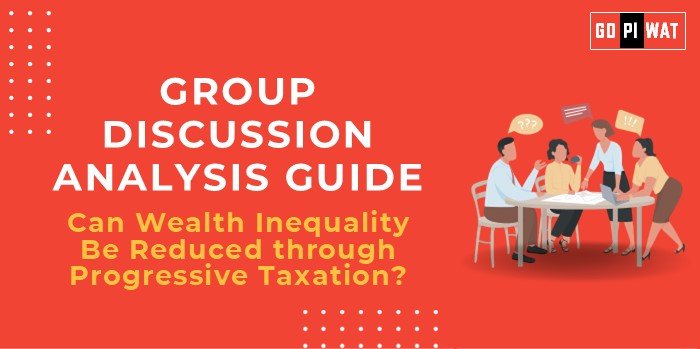📋 GD Analysis Guide
⚖️ Can Wealth Inequality Be Reduced Through Progressive Taxation?
🌟 Introduction to Wealth Inequality and Progressive Taxation
Opening Context: “Wealth inequality is a critical issue worldwide, with stark contrasts between the wealthiest individuals and the rest of the population. Progressive taxation is often proposed as a means to bridge this gap, by imposing higher taxes on those with greater incomes to fund public programs and social safety nets.”
Topic Background: The concept of progressive taxation dates back to economic theories aimed at creating a fairer distribution of wealth. Countries worldwide have employed varying degrees of progressive taxation to address wealth imbalances, from marginal tax rate adjustments to targeted wealth taxes. The debate continues about its effectiveness in reducing income disparities and ensuring equitable economic growth.
📊 Updated Quick Facts and Key Statistics
- 🌍 Global Wealth Inequality (2023): The richest 1% of the world’s population now owns 50% of global wealth (Oxfam 2023).
- 🇺🇸 U.S. Top Marginal Tax Rate: Currently 37%, down from a peak of 91% during the 1950s, showing changing attitudes toward taxing the wealthy.
- 📈 OECD Tax Progressivity: Average tax wedge for a single worker in 2022 was 34.6%; Belgium’s reached 52.6%, highlighting global variations.
- 🇸🇪 Nordic Countries’ Success: Progressive tax systems have led to low income inequality (Gini coefficient ~0.25).
- 🇮🇳 India’s Wealth Inequality (2023): The top 10% control 77% of the nation’s wealth (Credit Suisse Global Wealth Report 2023).
🔍 Stakeholders and Their Roles
- 🏛️ Government Bodies: Enact tax laws, allocate revenues to welfare programs, and create enforcement mechanisms.
- 💰 High-Net-Worth Individuals and Corporations: Participate in or resist progressive tax measures through compliance, avoidance, or lobbying efforts.
- 🌿 Civil Society and NGOs: Advocate for equitable tax policies, conduct research, and raise awareness of wealth inequality’s societal impact.
- 🌐 International Organizations: Provide policy recommendations and data analysis on tax systems (e.g., IMF, OECD).
- 👥 Citizens: Voters and taxpayers whose participation shapes public discourse on taxation fairness and redistribution.
🏆 Achievements and Challenges
Achievements:
- 💸 Revenue Generation: Progressive tax systems in Sweden fund extensive welfare programs such as free education and healthcare.
- 📉 Reduced Inequality: Scandinavian countries have among the lowest Gini coefficients globally.
- 📈 Economic Stabilization: Redistribution supports consumer spending among lower-income groups, boosting economic resilience.
- 🏠 Targeted Initiatives: Wealth taxes in Spain and France funded housing and employment programs.
Challenges:
- ⚠️ Tax Avoidance: Global tax evasion deprives governments of $427 billion annually (Tax Justice Network, 2022).
- 📉 Enforcement Barriers: Developing countries often lack administrative capacity to track and tax high-income earners.
- 💼 Capital Flight: Wealth taxes can lead to relocation of assets, as seen in France’s shift from wealth taxes to property taxes.
Case Studies:
- 🇸🇪 Scandinavian Success: High tax rates support robust public services and reduce income inequality.
- 🇮🇳 India’s Challenges: Low tax-to-GDP ratio (~10%) limits redistributive potential.
📄 Structured Arguments for Discussion
- ✅ Supporting Stance: “Progressive taxation can effectively reduce wealth inequality by ensuring that those with higher incomes contribute more to public welfare systems.”
- ❌ Opposing Stance: “Progressive taxation often results in tax evasion among high-income earners, limiting its impact on reducing wealth disparities.”
- ⚖️ Balanced Perspective: “Progressive taxation has the potential to reduce wealth inequality, but must be coupled with enforcement measures and additional policies to be effective.”
✨ Effective Discussion Approaches
- 📜 Opening Approaches:
- “With the richest 1% controlling half of the world’s wealth, progressive taxation has become a global policy debate.”
- “From the post-war era of high marginal taxes to modern times, progressive taxation has evolved significantly.”
- “Comparing Nordic models and U.S. tax policy reveals diverse outcomes from progressive taxation.”
- 💬 Counter-Argument Handling:
- “Successful enforcement measures in Nordic countries show how progressive taxes can work effectively with proper oversight.”
- “Complementary policies like closing tax loopholes and improving global tax cooperation can strengthen progressive taxation’s impact.”
🔍 Strategic Analysis of Strengths and Weaknesses
- 💪 Strengths: Redistributive impact on wealth, funding for public welfare programs.
- ⚠️ Weaknesses: Tax avoidance, potential disincentives for investment in high-tax regions.
- 🌱 Opportunities: Enhanced revenue for infrastructure and social welfare, reduction in social unrest.
- 🚨 Threats: Capital flight, tax competition among nations.
📚 Connecting with B-School Applications
- 💼 Real-World Applications: Analysis of taxation systems and public policies in economic courses, corporate finance, and macroeconomic projects.
- 🎓 Sample Interview Questions:
- “How effective is progressive taxation in reducing wealth disparities?”
- “What role does tax policy play in economic growth and stability?”
- 💡 Insights for B-School Students: Understand socio-economic policy design, its impact on development, and strategies for implementing equitable tax systems.


